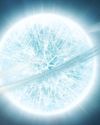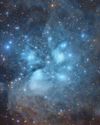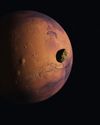
From a casual perspective, Saturn's iconic rings look almost perfect. Made up of billions of particles of ice and rock, which are thought to have come from comets, asteroids or shattered icy moons, they appear to seamlessly encircle the gas giant like a huge vinyl record. Since they were discovered by Galileo in 1610, the rings have become an immense source of fascination for astronomers, with so many discoveries having been made about them since. A lot of our knowledge of the rings came from the Voyager mission in the early 1980s, which gave us the first close-up images of the planet's complex system.
As Voyager 1 got within 50 million kilometres (30 million miles) of Saturn on 6 October 1980, it allowed astronomers to see some unusual marks. Rather than venturing in the same direction as the rings, they appeared to cut across them, like rods radiating from the centre of a wheel. Scientists had never seen this before, and they were intrigued to discover what may have been causing them. Named 'spokes' they've caught the imagination of researchers ever since. "The spokes are fascinating because they were so unexpected when Voyager flew by - we expected pristine icy and maybe rocky pieces, but didn't expect to see these ethereal dusty features," Dr Amy Simon, head of the Hubble Outer Planet Atmospheres Legacy (OPAL) program, tells All About Space. Yet there they were in all their glory, viewable again when Voyager 2 was within 4 million kilometres (2.5 million miles) of Saturn on 22 August 1981. And so a mystery was born.
Esta historia es de la edición Issue 143 de All About Space UK.
Comience su prueba gratuita de Magzter GOLD de 7 días para acceder a miles de historias premium seleccionadas y a más de 9,000 revistas y periódicos.
Ya eres suscriptor ? Conectar
Esta historia es de la edición Issue 143 de All About Space UK.
Comience su prueba gratuita de Magzter GOLD de 7 días para acceder a miles de historias premium seleccionadas y a más de 9,000 revistas y periódicos.
Ya eres suscriptor? Conectar

MYSTERIES OF THE UNI WHERE ARE ALL THE SPIRAL GALAXIES?
There are far fewer spiral galaxies than elliptical ones in the Supergalactic Plane, and scientists are keen to discover why

ZOMBIE STARS
+10 OTHER TERRIFYING SPACE OBJECTS

HOW TO BEAT LIGHT POLLUTION
Thought it was impossible to observe the wonders of the night sky from towns and cities? Think again. Follow our tips and tricks on successfully observing through sky glow

15 STUNNING STAR CLUSTERS
These beautiful stellar groupings are spattered across the cosmos

Eileen Collins "It was a difficult mission...we were the first to see Mir"
Having served as both the first female pilot and first female commander of NASA's Space Shuttle, Collins boosted the involvement of women in space exploration to a whole new level

MARS LEAKS FASTER WHEN IT'S CLOSER TO THE SUN
The Red Planet has lost enough water to space to form a global ocean hundreds of kilometres deep

FUTURE TECH KANKOH-MARU
This ambitious reusable spacecraft will be capable of taking 50 people to and from orbit

THE FINAL FRONTIER
Beyond the reach of the Sun is a fascinating region of the cosmos that were only just beginning to explore

A long-lost moon could explain Mars' weird shape and extreme terrain
A long-lost moon could explain why Mars is so different from the other rocky planets in the Solar System. Today Mars has two tiny moons.

A sprinkling of cosmic dust may have helped kick-start life on Earth
Cosmic dust may have helped kick-start life on Earth. New findings challenge a widely held assumption that this wasn't a plausible explanation.